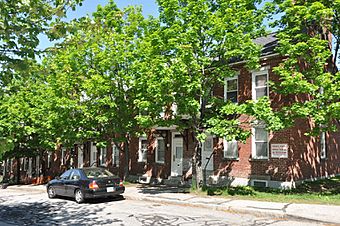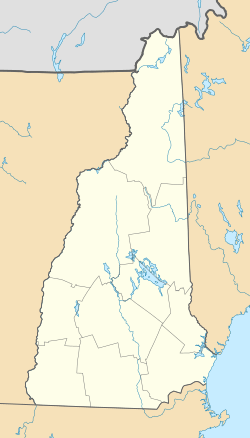District A facts for kids
Quick facts for kids |
|
|
District A
|
|

Row housing facing Granite Street in the district
|
|
| Location | Bounded by Pleasant, State, Granite, and Bedford Sts., Manchester, New Hampshire |
|---|---|
| Area | 6 acres (2.4 ha) |
| Architectural style | Greek Revival |
| MPS | Amoskeag Manufacturing Company Housing Districts TR |
| NRHP reference No. | 82000618 |
| Added to NRHP | November 12, 1982 |
District A is a special historic area in Manchester, New Hampshire. It was once home to many workers from the famous Amoskeag Manufacturing Company. This company had a huge factory nearby.
District A is located between Pleasant, State, Granite, and Bedford streets. It still has seven old apartment buildings. These buildings were built by the Amoskeag company between 1843 and 1852. They were added to the National Register of Historic Places on November 12, 1982. This means they are important to history.
Contents
What is District A?
District A is a rectangular area about 6 acres in size. It sits between the old factory buildings and downtown Manchester. The area is close to the Merrimack River.
What Did the Buildings Look Like?
The buildings in District A are made of brick. They are either 2½ or 3½ stories tall. Each building had six or ten apartments inside. Six of these buildings are arranged around a central open space or courtyard. The seventh building faces Granite Street.
All the buildings have strong brick walls. Their window sills and tops are made of granite stone. The entrances were updated later, in the late 1800s or early 1900s. The roofs are sloped, called gabled roofs. They have chimneys at the ends and between the apartments. Some buildings even have a brick wall connecting the chimneys at the ends.
Who Lived Here? A Look at History
The Manchester Mills Company started in 1839. They made special fabrics for clothing. Their factories began working in 1846. Soon after, they built homes for their workers.
The Amoskeag Company and Its Homes
Four apartment buildings were built near the factory's south end. Two of these buildings are still standing today. They were for workers who printed fabrics. Another four buildings were built near the north end of the factory. Three of these are also still here.
In 1850, the company built a new factory called Mill Number 2. After this, two more apartment buildings were added. These two buildings formed the courtyard you can see today.
Changes Over Time
Originally, there were ten of these apartment blocks. But over time, some were taken down. One building on the north side was removed in 1862. Two buildings on the south side were removed in 1974.
Other parts of the Manchester Mills housing still exist. You can find them in another historic area called District B.



